Report

This article is Section 2.1 of Bain’s 2020 Global Private Equity Report.
Is a bubble ready to burst in the tech sector?
That question has been gnawing at some private equity investors for a while. As alluring as the sector’s growth characteristics are, the red flags are hard to ignore.
Coming off a scary late-year dive in 2018, the Nasdaq powered ahead last year, driving price-earnings multiples in many tech subsectors to levels above their long-term average. The market value of just a handful of big tech players—Facebook, Apple, Amazon, Netflix and Google—ballooned to almost $4 trillion, which was more than 25% of the Nasdaq’s total market capitalization as of the end of last year.
At the same time, there were unnerving signs of investor fatigue in the market for initial public offerings. After posting strong share price growth for much of 2019, a cohort of newly public tech darlings like Uber and Spotify began to sell off in the wake of WeWork’s aborted IPO.
Clearly, at this late stage of the economic cycle, the risk of a market correction among the most inflated tech assets is significant. But, for several reasons, we believe it would be a mistake for private equity investors to huddle on the sidelines.
First, private equity tends to avoid the most hyped tech segments, investing instead in enterprise software companies that are more resilient in a downturn. Second, these companies have strong revenue growth and solid fundamentals because their customers are rapidly digitizing to stay competitive. Third, the sector has low levels of capital impairment because enterprise software is mission critical and the solutions are hard to dislodge once installed. Finally, the number of opportunities is growing. A wave of innovation around cloud and mobile technology has expanded the pipeline of PE-ready targets as companies mature out of the venture and growth stages of development.
The problem with the media-driven hype around tech stocks—both positive and negative—is that it treats “tech” as if it were monolithic. Capital flows tell a different story. Hardware and consumer software stocks comprise 63% of the capital invested in public markets, whereas 72% of private equity capital is concentrated in enterprise software and IT services (see Figure 2.1).
Compared with public markets, private equity is far less focused on hardware and consumer software companies

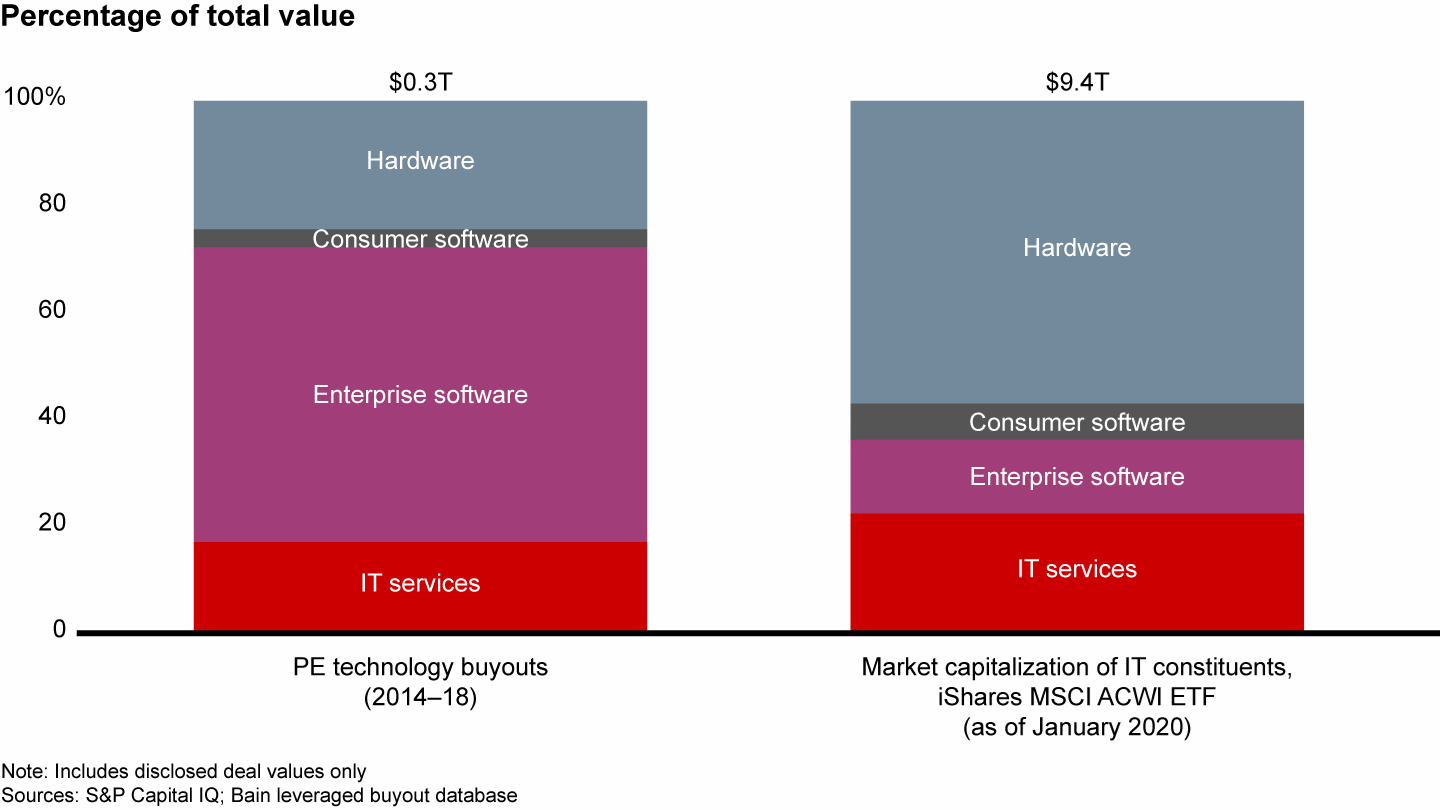
The distinction is important when it comes to risk assessment. Valuations for enterprise software companies have risen over the past five years, and their businesses are not immune to an economic slowdown. But these businesses tend to be more stable in a recession. While consumer-driven revenue can fall off sharply when the economy slows, B2B customers are less flighty. That’s because most enterprise software performs necessary business functions and is embedded in workflows, meaning the cost of implementing a new system and retraining employees can be substantial.
Enterprise software companies also win on fundamentals. Because so many of these technologies are still only midway along the adoption curve, especially among small and medium-sized businesses, there’s plenty of headroom for growth. Customer stickiness has always afforded the opportunity to raise prices, and SaaS-based subscription models create strong recurring revenue streams. Adding new customers is relatively inexpensive, and since these companies are asset light, they have a high rate of cash-flow conversion. That produces free cash to reinvest in more growth and to support more leverage.
These factors explain why returns from tech deals have outpaced those of nontech deals. Working with CEPRES, we broke down the returns from hundreds of private equity investments in technology-related companies from 2010 to 2018. The analysis shows that technology deals generated an average MOIC of 2.3x, while the rest of the PE market averaged only 2.2x over the same period. Software deals produced even stronger returns, with an average MOIC of 2.8x (see Figure 2.2).
Technology deals, especially software buyouts, have produced stronger returns than the private equity market overall

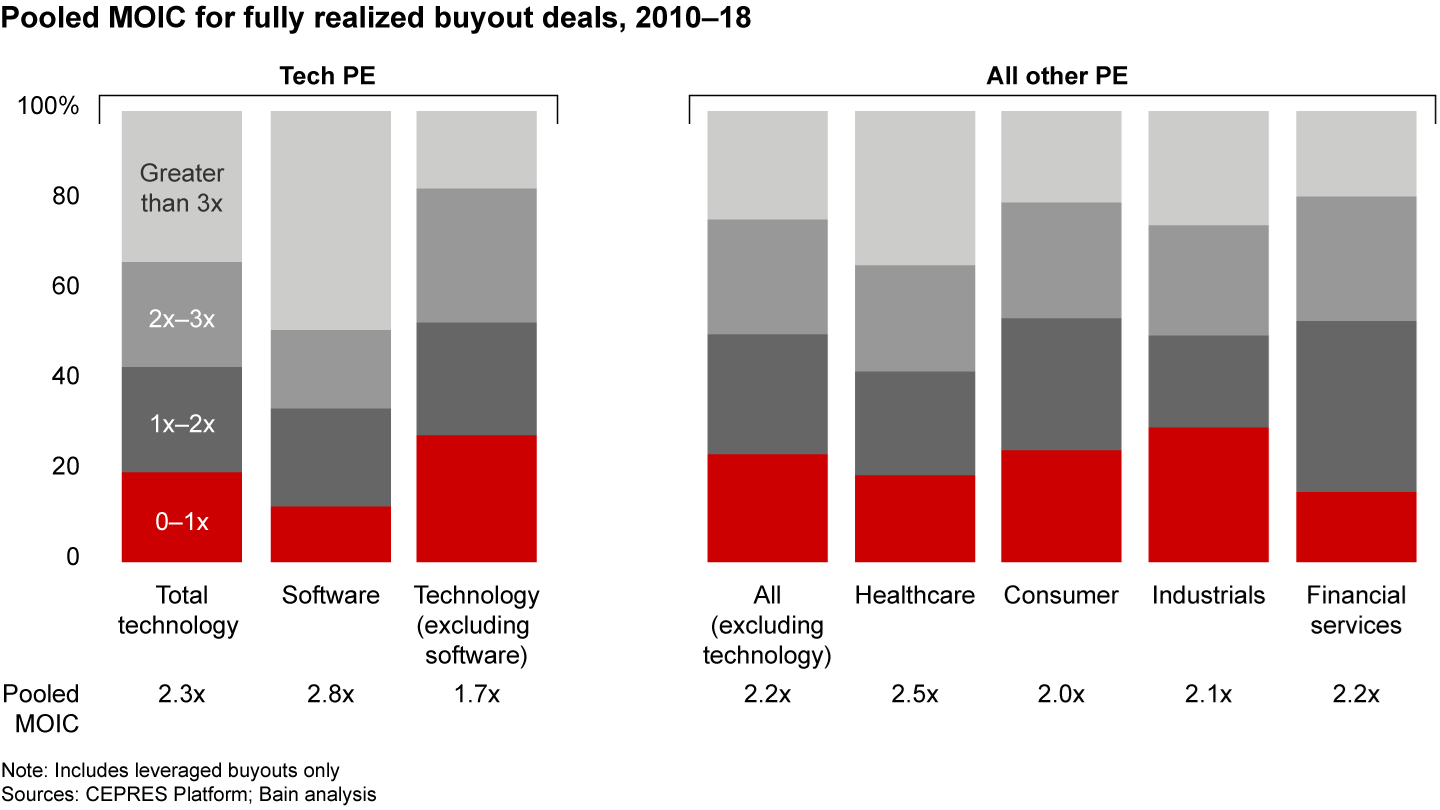
Steadily rising price multiples have contributed significantly to private equity returns in general during the current economic cycle, so it’s reasonable to ask how much multiple expansion has driven tech’s superior performance. But there, too, the sector’s fundamental strength shines through. Figure 2.3 compares the value uplift for fully realized tech buyouts from 2010 to 2018 to that of deals in other industries. It shows that tech in general and software in particular outpace other industries when it comes to generating value through EBITDA growth.
Growth in EBITDA accounts for more value creation in technology than in other sectors

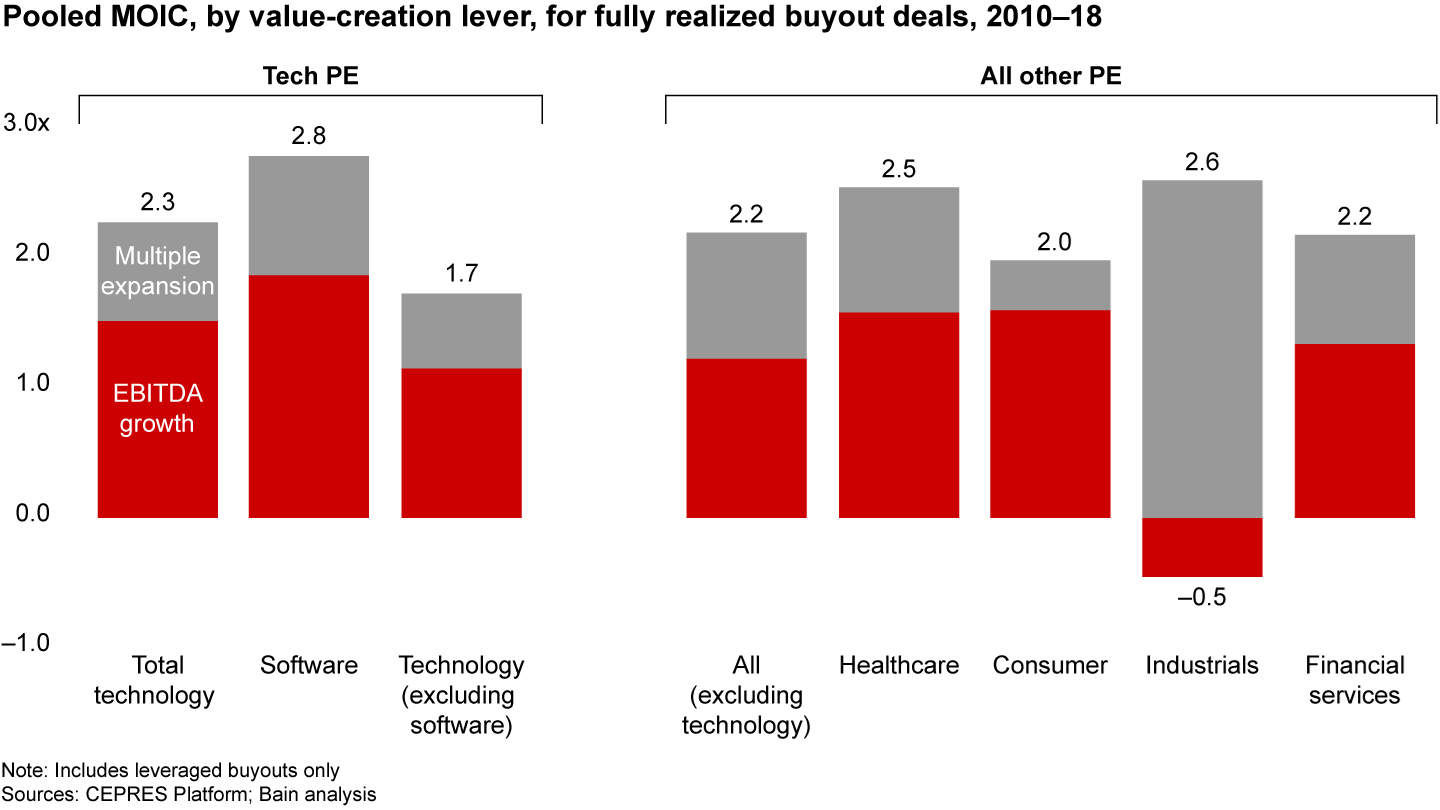
Yet focusing solely on EBITDA misses another important factor at play. Over the last five years, some private equity funds have made a fundamental shift in their mix of tech assets to emphasize revenue growth as well as earnings. This isn’t to say that the ability to produce profits is any less important. But growth and the investment to push it to full potential are critical.
For most of its history, private equity has put its money on legacy tech businesses—long-established companies with lower organic growth, like TIBCO Software and Rocket Software—that have a track record of high margins and steady earnings. In recent years, however, a new generation of born-on-the-cloud software and services companies have been attracting more and more investment. In 2018, over 50% of software LBOs targeted companies transitioning to the cloud, up from just under 10% in 2014. These companies are game changers: They are disrupting their markets and growing rapidly as businesses move away from clunky on-premise enterprise software. But it’s also true that they have lower margins, or even losses, because they are investing heavily in product development, sales and marketing to sustain their growth.
Tech investors use the Rule of 40 to get at this dynamic. It states that the sum of revenue growth and profit margin for a healthy software business should exceed 40%. A legacy software business growing at 5%, for instance, would be expected to generate 35% margins. But a new SaaS business growing at 50% arguably should be losing money—because if it isn’t, it may not be investing enough to reach its potential.
Revenue multiples capture this growth/investment relationship better than EBITDA. A great example is Vista Equity Partners’ 2016 buyout of Marketo, a cloud-based innovator in marketing automation software. Marketo was losing money and its revenue growth had stalled in 2016, when Vista took it private for $1.78 billion, a 64% premium to its stock price and 7.9x revenue. Wall Street scoffed at the valuation, but Vista installed a CEO experienced in reinvigorating revenue growth, who focused the company’s sales effort on large deals in the enterprise space. Rapid growth eventually produced positive EBITDA, and in September 2018, Vista sold the company to Adobe for $4.75 billion, generating a $3 billion return.
High price multiples certainly do turn up the heat on GPs hoping to replicate the market-beating returns tech investments have generated in the past. The supply of targets is growing as the number of high-growth, born-on-the-cloud companies increases. But competition for deals from both investors and strategic buyers will continue to ramp up as capital aimed at the sector grows. Several large tech specialists raised major new funds in late 2018 and 2019, including Vista’s $16 billion Fund VII and Thoma Bravo’s $12.6 billion Fund XIII. Other large firms have launched specialist tech funds, including Advent and Bain Capital.
In all, new private capital aimed at tech approached $150 billion in 2019. It’s hard to predict how this supply/demand dynamic will play out, but it is likely to intensify the upward pressure on valuations in the years ahead, challenging GPs to pick assets wisely and execute during ownership.
What follows is our assessment of three high-growth enterprise software sectors: cybersecurity, human capital management and DevOps. Each benefits from broad and lasting changes in corporate behavior, and each is maturing as a hunting ground for private equity investors. But finding growth and exploiting it are two different challenges, especially in a market where growth may already be baked into multiples. Succeeding in this environment will require a clear, differentiated investment thesis and underwriting it reliably in due diligence. For many firms, that will mean cultivating a new set of capabilities to help portfolio companies manage rapid growth and invest behind it boldly.
Cybersecurity: The race to stay ahead of growing threats
Hardly a day goes by that the media isn’t trumpeting the latest security breach at a major global corporation. In 2018 alone, firms reported over 2 million cybersecurity incidents resulting in more than $45 billion in losses. As IT infrastructure becomes increasingly complex and central to everything a company does, the danger to organizations and their leaders is hard to overstate. But from an investment standpoint, the business of mitigating those threats presents a major opportunity.
Hunting for deals in the burgeoning cybersecurity sector is complicated by the sheer number and diversity of targets, many of them growth-stage insurgents that are just now emerging onto PE radar screens. It helps to filter subsectors using a handful of factors: How much is the underlying technology changing? How much unaddressed white space is there? How long is the product life cycle, and how sticky are the customer relationships? How fragmented is the market, and how high are the barriers to entry (see Figure 2.4)?
Several cybersecurity subsectors are particularly attractive for private equity investors

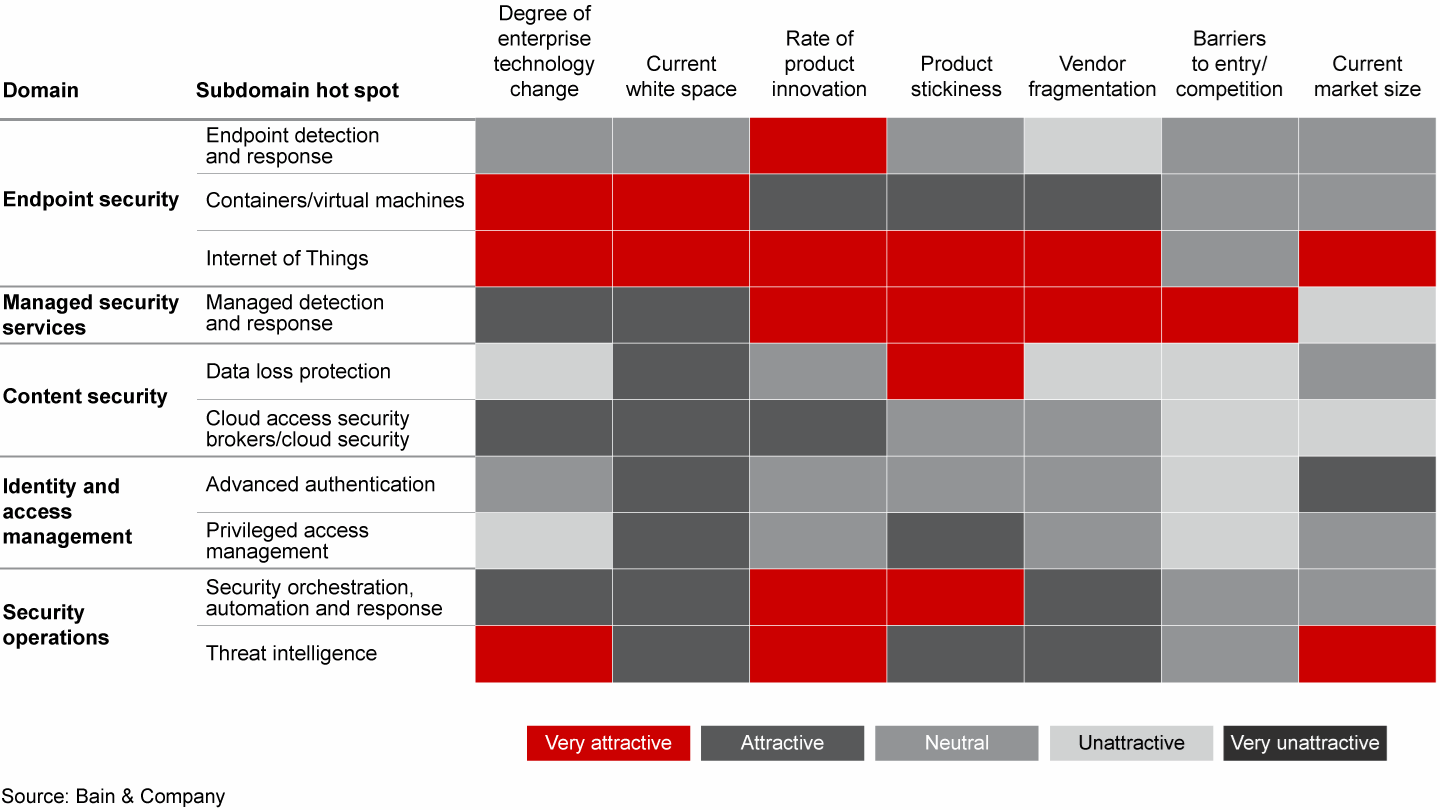
Based on these criteria, several subdomains stand out within the broader areas of endpoint security, managed security services and security operations.
- Internet of Things (IoT). Because IoT devices imbue systems like factory equipment or commercial HVAC systems with intelligence, they’re in heavy demand. But they also create massive security gaps at the outer ring of networks, slowing adoption. The vendors supplying cybersecurity solutions are mostly small companies, which gives PE buyers the opportunity to buy and build, creating a scale player through acquisition.
- Containers. A container is a standardized piece of software that allows a company to move an application from one computing environment to another without compromising speed or reliability. Like IoT, the technology presents unique security challenges, which has spawned a fragmented industry of cybersecurity firms. A number of the most promising have been gobbled up by strategic buyers like Cisco and Palo Alto Networks, but there is ample white space to fuel growth of new targets.
- Managed detection and response. Given the specialized nature of cybersecurity, it’s not surprising that many large enterprises outsourced the job. That gave rise to a subdomain called managed security service providers (MSSPs), companies that monitor security threats. Increasingly, MSSPs are giving way to managed detection and response (MDR) companies that not only monitor threats but also automate a response. The most attractive MDR firms have developed strong customer relationships based on packaging the right solutions from the best underlying technology.
- Security orchestration, automation and response (SOAR). Coined by the research firm Gartner, SOAR refers to tools deployed by companies to automate security operations. The idea is to use machine learning and analytics to take people out of the equation. This is a nascent area of cybersecurity, and companies are still learning how to put these systems to work. But the growth is substantial, and rapid adoption promises to create opportunities for investors willing to accept some growth-stage risk.
Competition for assets within each of these segments is fierce given the latent demand for cybersecurity solutions. To win, PE investors need to understand how the underlying technology is changing and how a given asset is positioned to take advantage (or not). Rapid growth can easily stall if a target lacks a truly differentiated advantage. Commoditization is a real risk in cybersecurity as technologies mature and gain wide acceptance, eroding favorable pricing dynamics. How well a product works across platforms and architectures is often critical to staying a step ahead. So is targeting the right segment and developing the go-to-market capabilities needed to pursue it.
As cyber threats proliferate and the technology to mitigate them evolves, the cybersecurity sector will continue to offer up a variety of attractive opportunities for all types of investors. The challenge for PE funds is acquiring the market experience and sophistication to evaluate deals and underwrite growth more effectively than the competition.
The human capital imperative
For years, human resources executives have been looking for technology to make their jobs easier, and for years they’ve been largely disappointed. Software tools patched together from legacy systems are typically clunky, inefficient and rarely designed to talk to each other. Many HR departments still go their own way, turning to Excel spreadsheets as a solution for many tasks and workflows.
But that’s changing rapidly as human resources rises from a staff function at many companies to a full C-suite participant. Leadership teams increasingly view winning the war for talent as critical to all they do, and they are investing accordingly in human capital management (HCM) software—systems to help automate everything from talent acquisition to benefits and employee development. Not only are processes becoming more complex, but employees are becoming more demanding: When they log onto the employee portal, they expect self-service options and personalized HR solutions. Companies are looking to become more competitive by improving employee engagement and using predictive analytics to find and develop talent.
Legacy technology clearly isn’t cutting it. Bain research shows that three-quarters of HR departments believe their current IT systems aren’t achieving optimal performance, and 25% are planning to expand technology budgets by more than 10% over the next two years. IDC projects companies will spend $90 billion on HCM software over the next four years, an updraft that has already produced rapid growth at companies like Workday, Ultimate Software and iCIMS. Private equity investors have taken notice. The number of HCM buyout deals tripled to 12 from just 4 in 2015. The clear appeal is the chance to ride the penetration curve in a dynamic sector characterized by eager customers with an increasing willingness to pay.
Automating HR workflows, however, is more difficult than it seems. While most corporate functions—finance, for instance—have standard ways of doing things, HR functions like talent management tend to differ by company and are often an embodiment of the corporate culture. Automating these processes can be both complicated and disruptive, meaning customers are less willing to change the workflow to suit the software. “Land and expand” (software-industry parlance for getting in the door with one application and introducing others across the same customer base) might work with one customer group. But it might distract from producing best-of-breed solutions for customer groups that need to solve a narrowly focused problem.
The most effective diligence processes in the HCM space zero in on whether a target company has defined its market correctly. That often boils down to the size of its customers and the complexity of their business (see Figure 2.5). Small to midsize companies with fewer employees and resources are more willing than larger companies to accept “good enough” software solutions, making it easier to sell them a suite of products that makes automation affordable. Land and expand may work in such instances, but it could be equally important to invest in a sales and marketing team capable of targeting the thousands of small companies that might be looking for relatively simple solutions.
A company’s size and complexity tend to determine its choice of suite software vs. best-of-breed solutions

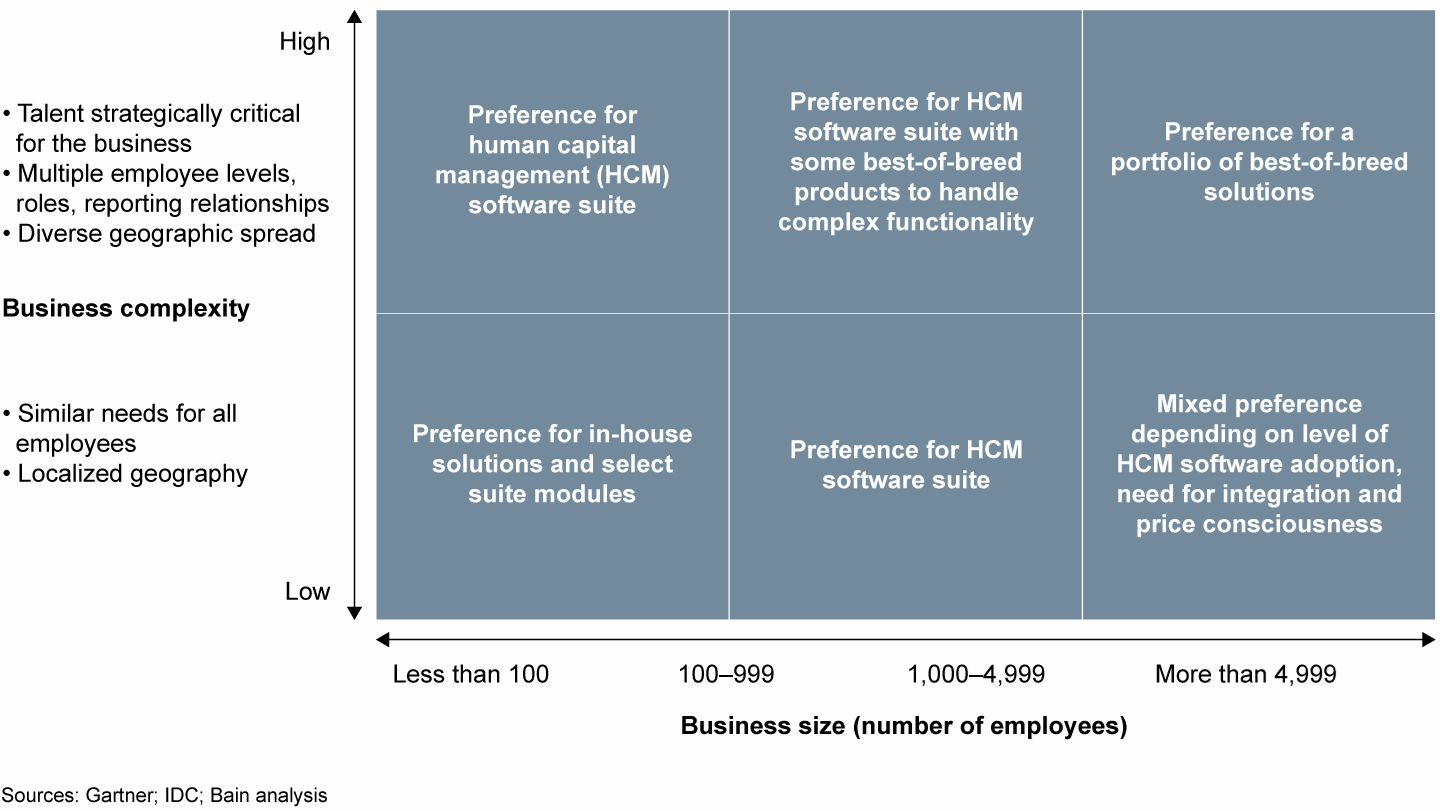
That was the case when HgCapital bought Germany’s Personal & Informatik (P&I) from Carlyle in 2013, in a deal that valued the company at €438 million. P&I had strong positions in software used to manage payroll and employee records. It had a diverse and loyal customer base of small and medium-sized German companies and a decade of consistent growth in revenues and EBITDA.
Hg saw the chance to expand on this success through cross-selling new products to P&I’s sticky customer base. The company had developed a suite of talent management products for customers looking for cloud-based solutions to help with recruiting, performance management and workforce analytics. P&I expanded its suite offering with additional modules and functionality to match the market need.
The strategy worked. Over the three years Hg owned it, P&I grew rapidly, expanding EBITDA at 16% annually. Hg sold its majority stake to Permira in 2016, realizing a 36% internal rate of return from the investment.
The trap is to assume that the same approach will work for any customer base. Large, enterprise-level customers present a different challenge. The bigger the company, the more complex its HR processes, so a large enterprise is typically willing to pay for best-of-breed functionality for each of its workflows.
In talent management, for instance, the imperative is to stay ahead of the competition by identifying, onboarding and developing the best people. It means giving employees distinctive, personalized experiences when it comes to benefits management and engagement. Each of these areas represents a precise need, and a large company with extensive resources would much rather manage a patchwork of world-class solutions than trade off on functionality for a suite. HCM companies trying to be the best at all things are likely to come up short.
When Warburg Pincus invested in Businessolver in 2018, building up the core was at the center of its investment thesis. Indeed, Businessolver had thrived as a provider of benefits-administration software precisely because of its focus; its SaaS-based solutions gave customers more of what they needed than they could get with legacy offers from players like Oracle or suite providers like Workday. The Iowa-based company catered to midsize and enterprise-level businesses that needed flexible solutions for managing an ever-more-complex mix of medical plans, health savings accounts and ACA-mandated reporting requirements. They needed robust back-end functionality as well as a slick web-based interface and mobile app to help employees educate themselves on plan features and trade-offs.
Businessolver had defined its market carefully and targeted its R&D to stay within those boundaries. For Warburg, it could drive upside in helping the company invest in technologies like artificial intelligence (AI) and machine learning, which could allow customers to get answers to complex benefits questions quickly or let management use “instant dependent verification” to weed out ineligible participants. Businessolver has expanded gingerly in areas where it knows it can add value—products to manage commuter benefits, for instance. But winning is about continuing to deliver specialized solutions for its core customers.
Cookie-cutter strategies won’t work in a sector as complex and multifaceted as HR. Understanding how to define boundaries and grow within them is the key to value creation.
The DevOps paradigm shift
Until relatively recently, most companies viewed building software applications and managing them as two separate functions. Someone established a need and drew up a project plan. Then, over the course of weeks or months, the development process would proceed step by step until a monolithic application was ready to be put into service, at which point it would be deployed and maintained by IT operations. Not only was this waterfall process ponderous, it was inflexible. Once an application was up and running, fixing a bug or adding a competitive new feature involved launching another new process. Companies were stuck, held hostage to the next development cycle.
The explosive pace of innovation in today’s markets has dictated a new paradigm. Known as DevOps, it makes companies faster, smarter and much more flexible, allowing them to work effectively within modern IT architectures like the cloud, containers and microservices. DevOps uses many small, multifunctional teams that each own a smaller app or service. They use Agile development principles to rapidly plan, build and test their app, improving it continuously as they run, service and fix it. Adopting DevOps can reduce release cycles by orders of magnitude. Amazon, for instance, has taken DevOps to scale and now deploys new code more than 5,000 times daily.
The paradigm shift has opened a rich new vein of investment potential. A recent Bain survey indicates that, while most companies are already using DevOps in some capacity, only about 10% are using it for a majority of their applications. Over the next five years, however, 50% of companies expect to be using DevOps at scale, which means big changes for the tech ecosystem (see Figure 2.6).
Companies expect to significantly increase their use of DevOps over the next several years

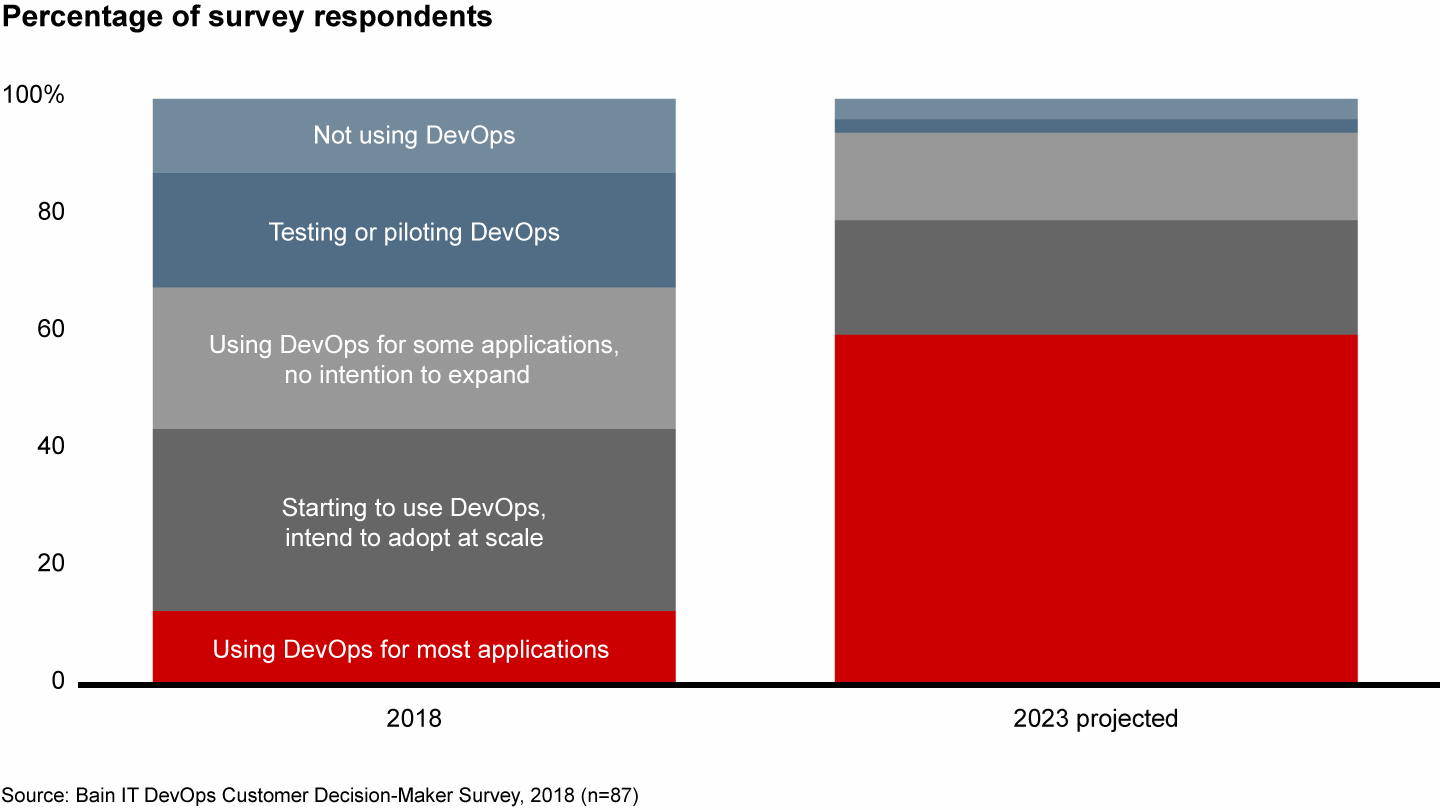
As companies adopt DevOps, they are replacing legacy tools with a new generation of technology that supports collaborative, continuous, and automated development and operations. Teams are reorganizing, and decision making is decentralizing, moving away from the CIO. DevOps is also altering the competitive landscape as cloud services firms like Amazon Web Services provide their own DevOps tools to entice companies to use their infrastructure. Open-source platforms, meanwhile, are gaining traction by offering companies alternatives that are often free.
The fast-growing market is attracting enthusiastic investment across the board, from late-stage growth and private equity funds to strategic buyers and cloud service providers. The number of deals in the sector has increased fourfold since 2015, with the value of the market growing 26% year over year since then.
Rapid innovation, however, creates a heavy dose of risk for any investor. Funds are underwriting deals with a variety of strategies, but the most successful recognize the critical importance of being on the right side of change or having a clear plan to get there. That means gaining real insight and confidence about several key factors:
- Are the company’s offerings differentiated, and do they work with modern architectures like the cloud and microservices?
- Is the company a leader (or moving toward leadership)?
- What role does open source play in the company’s segment, and is its revenue model sustainable?
- Is the target company wired in with the DevOps teams that are replacing heads of IT as the key decision makers when it comes to assessing and buying these tools?
When Thoma Bravo bought Detroit-based Compuware in 2014 for $2.4 billion, the company looked more like a legacy cash cow than a tech innovator. What sparked Thoma’s interest was an acquired unit called Dynatrace that developed application performance management systems for old-line enterprise IT systems.
Dynatrace was a diamond in the rough. It had fallen behind in the monitoring business to companies like AppDynamics and New Relic, whose products performed better and were easier to deploy. But it also presented the opportunity to build a new product architecture suited to the DevOps paradigm. To get there, Thoma Bravo spun Dynatrace out as a separate private company and began investing in it as a standalone entity.
Legacy monitoring products forced companies to use separate tools to check up on applications, IT systems and other aspects of the IT stack. But as customers gravitated to the cloud, thousands of applications might be running across many computing environments at once, presenting a much more complex and dynamic monitoring challenge. That meant monitoring companies had to make their products more intelligent and tie them together to give users a single view of what was going on.
To provide this kind of functionality, Dynatrace rebuilt its product from the ground up. It engineered new solutions to serve the next generation of architectures, integrating many of the components that other vendors either didn’t have or had not yet integrated. It also developed an easy-to-use dashboard that let managers see what was happening across the company all in one place.
Strong advocacy from DevOps teams led to rapid adoption and a fivefold increase in the number of customers. Subscriptions now make up about 90% of Dynatrace’s revenues as it transitions from licensing on-premise software to solutions delivered and updated dynamically through the cloud.
The growth led Thoma Bravo to take Dynatrace public in March 2019 in an IPO that raised $544 million to fuel more growth and valued the company at $4.5 billion. Thoma Bravo retained its 70% stake, for a market valuation of about $5.5 billion so far.
It’s unsurprising that Thoma Bravo’s biggest opportunity in the DevOps space to date has been transforming a legacy player. Given the highly fragmented nature of the market, many of the most promising targets are still in growth stages and not yet on PE radar screens. But that’s changing rapidly as companies mature, creating opportunities to back disrupters emerging from the venture world. There will be chances to build scale players either by rolling up companies with similar technology or by bundling those that complement each other to create new toolchains.
Success will depend on the ability to develop proprietary insights about a rapidly evolving business and translate them into a strong value-creation plan. We see the most opportunity to do so in three key subsectors:
- Developer workflow tools. Companies have spent heavily over the years for legacy development tools, fueling strong PE investment in tool vendors like Perforce and BMC. The rise of DevOps means those companies are fast ceding share to next-generation tools supporting workflows like continuous integration and deployment (CI/CD). Until now, this segment has been extremely fragmented, and widespread use of free, open-source tools like Jenkins has held back revenue growth. But that’s changing as companies create integrated toolsets and offer paid tiers for enhanced products and services.
The developer workflow segment represents a $2 billion to $3 billion market and is growing at around 10% annually. Companies like GitLab and HashiCorp are reaching a size and critical mass that make them increasingly attractive to PE funds interested in growth assets.
- Testing. Testing has always been critical to software development and is a massive, $30 billion market that is growing at 13% annually. But from an investment standpoint, the space is complex, fragmented and evolving rapidly. There are many vendors across different testing methods (unit, integration, security and usability testing, among others) and a wide array of outsourced testing services. Because DevOps teams are rapidly and continuously developing new code and putting it to work, the new model demands faster, consistent testing that doesn’t rely on humans. Companies are also moving away from traditional quality assurance teams and relying on the DevOps teams themselves to test as they go.
While the market is broadly growing and providing a diverse range of investment opportunities, the greatest promise lies with innovative companies whose products are aligned with the trend of automating or augmenting testing. Applause and SmartBear are good examples.
- IT operations management (ITOM). This is where Dynatrace plays. ITOM is a set of tools used to instrument, monitor, manage and remediate application and IT infrastructure—all mission-critical tasks. A $10 billion segment that is growing at 10% annually, it has recently produced a number of large deals besides Thoma Bravo’s Dynatrace IPO, including Cisco’s $3.7 billion acquisition of AppDynamics, Splunk’s $1 billion purchase of SignalFx and the $7.8 billion IPO of Datadog. DevOps teams will continue to demand these tools, and the trend toward “integrated observability” is creating opportunity for vendors that can bundle previously unrelated monitoring tools into suites that use artificial intelligence to increase automation.
What’s clear is that DevOps is here to stay, and companies across the economic spectrum will need to get on board if they want to remain competitive. That will open the door to PE firms, much as the rapid emergence of PE-ready companies in cybersecurity and HCM software is creating opportunities for investors with the right combination of risk tolerance and industry-specific experience.
Private equity has always excelled at managing for cost and scale. In many technology sectors, PE funds have generated solid returns by investing in legacy players that offer average growth but steady streams of reasonably predictable earnings. That’s changing rapidly. Funds flush with capital are looking for new hunting grounds, targeting companies they might never have considered in the past. They are identifying opportunities in maturing enterprise software sectors attractive for their positive growth, cycle resilience and strong cash-flow fundamentals.
The best of them are also deploying new tools to evaluate these assets. They are learning to use benchmarks like the Rule of 40 to identify and invest boldly in underfunded growth companies. They are consolidating fragmented subsectors and creating scale economics through buy-and-build strategies. They are helping companies define their markets correctly and build the right commercial capabilities to execute effectively.
What they aren’t doing is diving in cold. Managing the risk associated with these sectors starts with tapping the right ecosystem and assembling the right expertise. It means shifting old mindsets and building new capabilities to aggressively manage for growth.
Explore the report
More from our 2020 Private Equity Report
Private Equity Report
This article is part of our 2020 Global Private Equity Report.